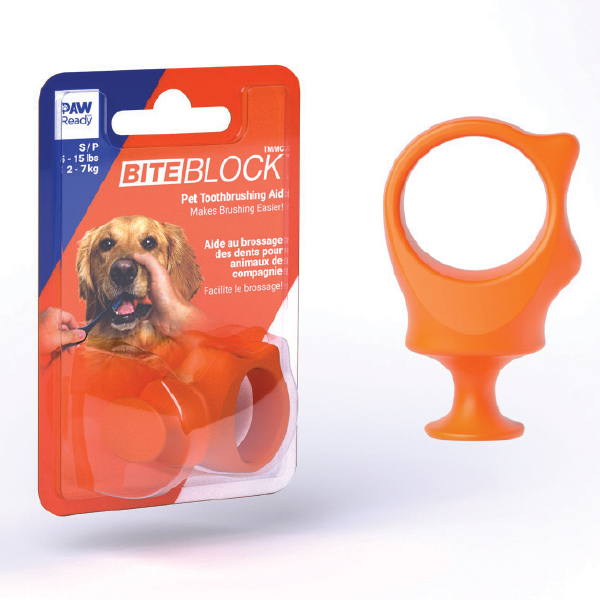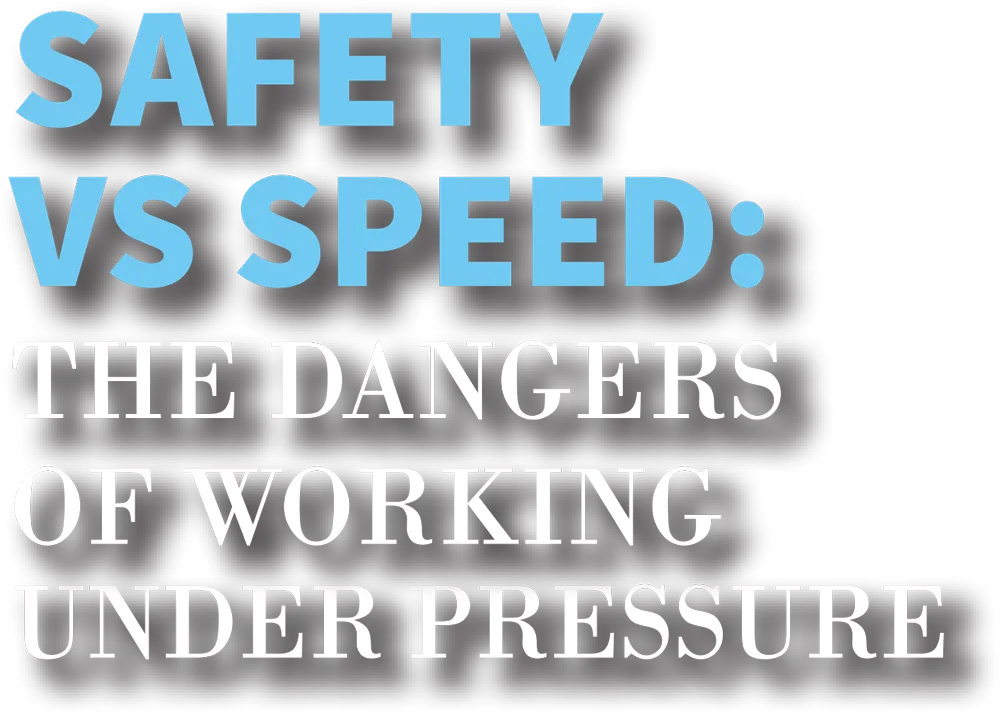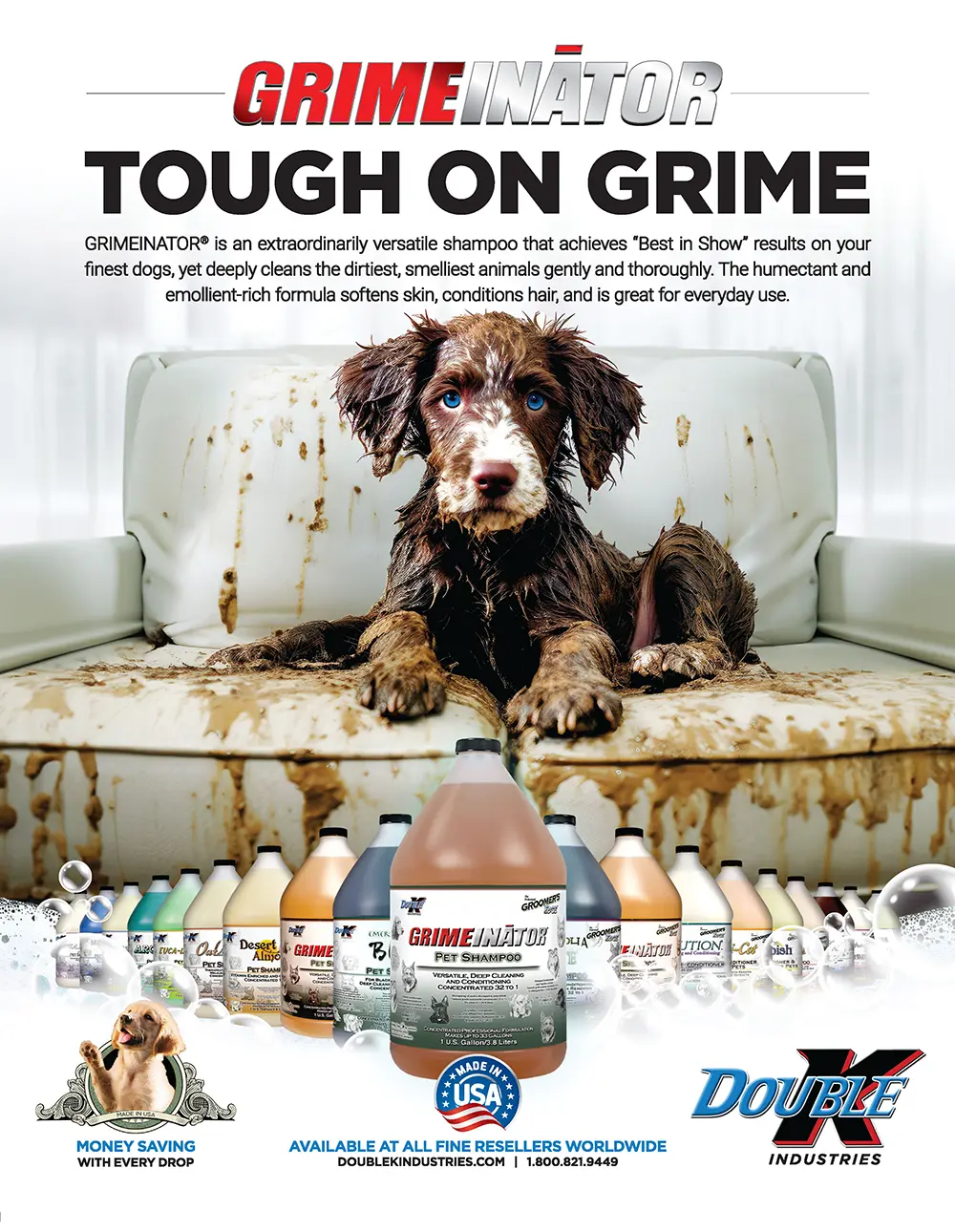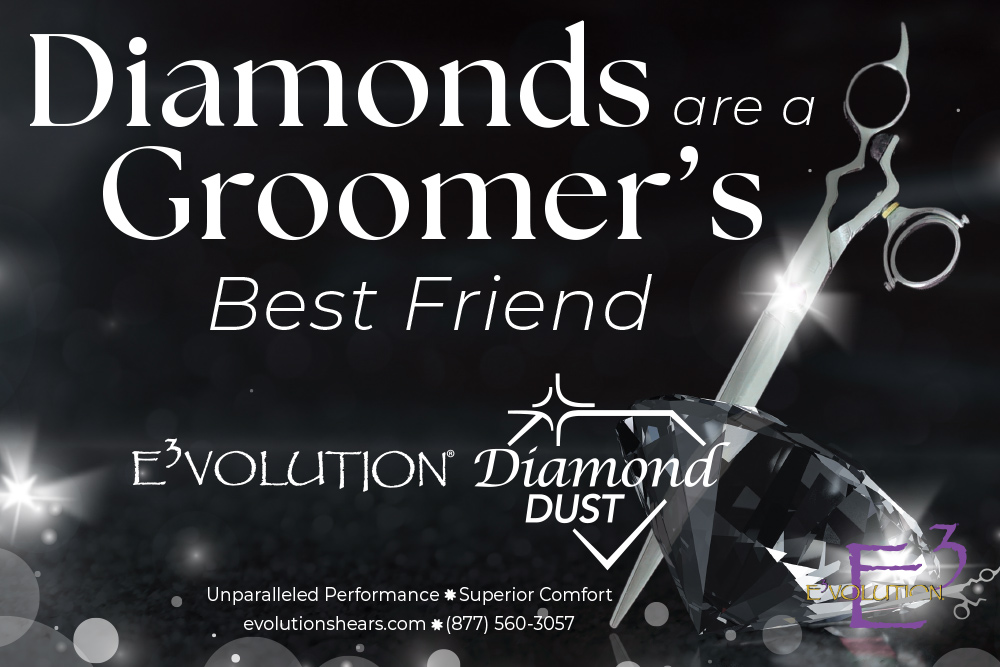Contents | February 2024
20
by Dr. Cliff Faver
40
by Kathy Hosler
ALSO INSIDE
todd@barkleigh.com
adam@barkleigh.com
gwen@barkleigh.com
rebecca@barkleigh.com
luke@barkleigh.com
laura@barkleigh.com
brandi@barkleigh.com
carlee@barkleigh.com
evan@barkleigh.com
cassidy@barkleigh.com
allison@barkleigh.com
james@barkleigh.com
karin@barkleigh.com
britany@barkleigh.com
Daryl Conner
Jonathan David
Dr. Cliff Faver
Blake Hernandez
ALSO INSIDE
ON THE COVER

it’s advertisers for their continued support.
- Andis2
- Animal PhotographyDigital Only
- Bandanas Unlimited42
- Best Shot PetDigital
- Best Shot Pet38
- Chill Paws Pet CBD26
- Cocojor16
- Cool Dog Wash Tubs21
- Cosmos Bathing Systems12
- Direct Animal Products17
- Double K Industries3
- Electric Cleaner Company8
- Envirogroom | Special FX Premium Products47
- Evolution Shears7
- Groomer’s Best32
- Groomer’s Choice4
- Groom’d52
- Groomers Mart28
- Groomers Mart – Show Season25
- Groomore41
- Groomsoft29
- Happy Hoodie54
- IV San Bernard USA18
- Jodi Murphy Pet Products39
- Laube55
- Metrovac34
- Paragon School of Pet Grooming19
- Pet Biz Insurance9
- PetStar UK – ShakeYourTail11
- Pet Vet Magazine27
- Precision Sharp31
- Puppy Playground33
- Quadruped Pet Care35
- Ryan’s Pet Supplies56
- Ryan’s Pet SuppliesDigital Only
- Stazko37
- Stone Mountain Products51
- Thera-Clean49
- Tool Klean22
- Vanspeed15
- Wag’n Tails13

by Mary Oquendo
re you even a groomer if you haven’t gotten bit?
This sentiment will have feuding groomers come together over shared stories. But why is that? Is it in our job description? Is it an assumed risk?
Well, there is the “Assumption of Risk.” This is a legal doctrine that says you cannot sue for injury when you voluntarily expose yourself to a known risk. It falls into three categories: Primary, Expressed, and Implied.
Primary Assumption is mainly associated with sports. You understand that you can get hurt when participating in any sport; you can’t sue if you break a leg sliding into home plate.
Expressed Assumption involves written contracts and waivers. If you’re a firefighter, you sign a contract stating you won’t sue the city because of burn injuries. It’s a requirement of employment. However, this Assumption can be a gray area. Did the contract communicate the danger? If not, the court may nullify it. State laws vary, and a lawyer should write an agreement to ensure it will hold up in court.
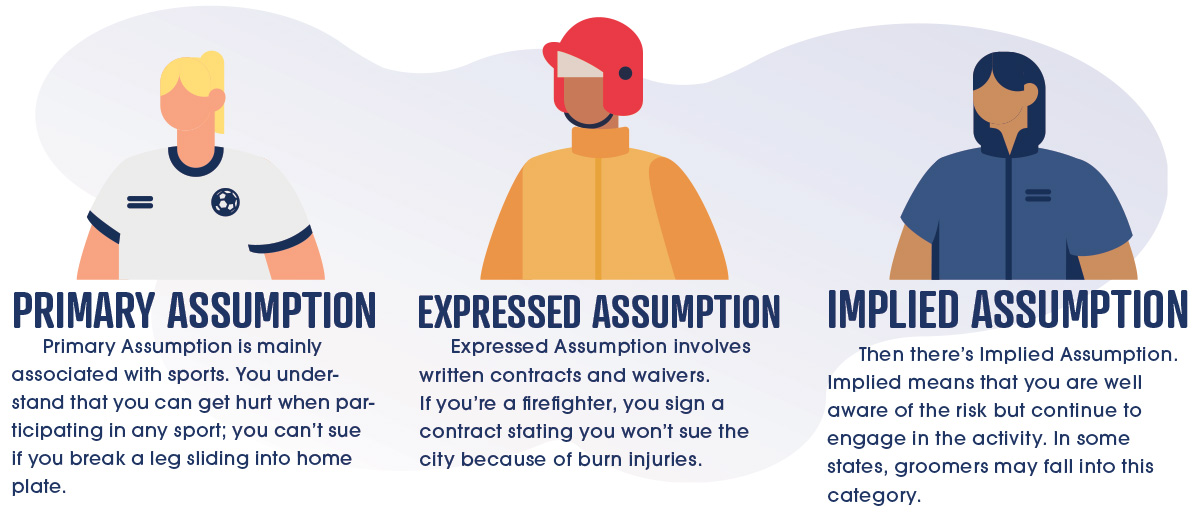



Well, here is a real-life example of an incident involving Evthoxia Moustakas, a mobile groomer from CT, told from her point of view:
“I went to a new-to-me Bernese Mountain dog’s house. One of my coworkers groomed this dog six months prior but did not update notes on the dog. I did my usual 30-minute new-client intake regarding all aspects of the dog’s behavior, and the owner swore up and down the dog was fine with no issues.
His coat was impacted, and he was overweight at about 160 lbs. I managed to get him on the table and into the tub, and all was going well. I’m all of 5’ 3”, and his shoulders were above my head level. He’s massive. As I’m doing a deshed bath, there’s a lot of turning him back and forth so I can thoroughly saturate and work the coat.

As much as I wanted to react toward this dog, he was at a higher elevation than me, and he had perfect access to my face. Fortunately, I had my Bluetooth headphones in and called my managers at the office. They told me to hang tight, as they were on their way and to call the cops.
I ran out of the van and left the still-covered-in-shampoo dog tethered in the tub. My only concern was for my safety. I reach the client’s door, banging on it with my elbows, screaming for her. She came to the door and looked at me and her wet dog, who somehow managed to get out of the van and was now circling me. I told her what happened, that my managers were on their way and the police were coming, and all she could say was, “Yeah…he’s got a tendency to randomly attack and bite people for no reason…”
I just stared at her. I reminded her that I asked her for this information BEFORE the groom so I could make an informed decision if it was safe enough for me to groom her dog.
I got a ride to the hospital in an ambulance, with one of my managers driving behind me while the other took my van back to our shop.
Two years later, I refuse to groom a Bernese or even look their way. I was out of work for five weeks and still have issues with my hands.
The dog now had a record with the state, not just the town. That was all. The cops weren’t interested in filing charges. One more bite report though, and the dog will be put down.”
While Evie’s story is not an uncommon one, it is certainly unfortunate.
So, how do we protect ourselves?
 Ask the right questions.
Ask the right questions.
One of my client forms had five questions, each requiring an answer and a signature at the bottom. They included: Has your dog ever bitten anyone? If so, under what circumstances? Has your dog ever bitten a groomer or any pet professional? If so, under what circumstances? Has your dog ever tried to bite a pet professional?
 Keep updated notes.
Keep updated notes.
In Evie’s case, the last groomer noted behavioral issues but never entered that info in the client’s file. As there were no notes on this dog, Evie did specifically ask and was told by the owner the dog was fine. She did not have the necessary information to make an informed decision regarding Implied Assumption. She was not given the opportunity to refuse the grooming of a dog that bites without warning. And without written or video-recorded acknowledgement, this situation would end up as a he-said/she-said scenario.
 Require signed waivers.
Require signed waivers.
Legally enforceable signed waivers informing the owner of responsibility for pet bites in your state will go a long way in protecting you from a legal standpoint. A business lawyer should draw up this form so that it is legally enforceable in your state.
 Pay attention to body language.
Pay attention to body language.
Look for those warning cues. If you’re still unsure of what to look for, there are some great behavioral programs out there.
 Do a thorough check-in.
Do a thorough check-in.
Identify those pain points on the pet before grooming, as this can be a trigger for aggressive behavior.
 Use available safety aids.
Use available safety aids.
There are too many safety equipment options to list. The best place to see them is at trade shows or ask for recommendations from your colleagues.
 Know when to refuse or stop a groom.
Know when to refuse or stop a groom.
You do not have to groom any pet just because they made an appointment.
And to answer the original question—No, getting bit is not in our job description. It only takes a split second to change your life, so you must take all possible precautions to keep yourself and the pets you are grooming safe, which is in our job description.
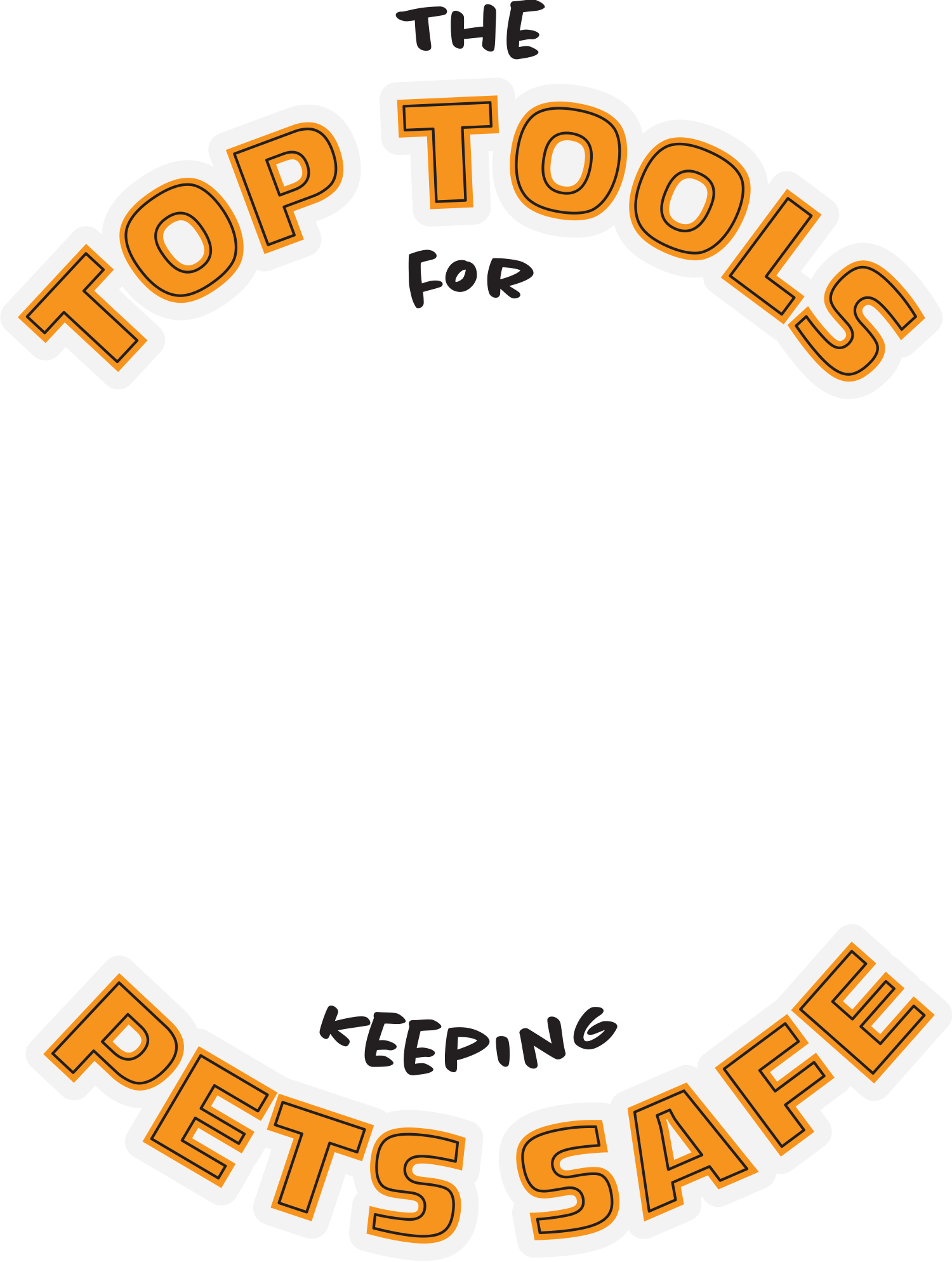
 rom brand-new groomers to seasoned pros, our number-one job is not executing the perfect haircut—although that is near the top of the list. The most important thing is keeping the pets in our care safe while we groom them.
rom brand-new groomers to seasoned pros, our number-one job is not executing the perfect haircut—although that is near the top of the list. The most important thing is keeping the pets in our care safe while we groom them.
Poet Maya Angelou once wrote, “Do the best you can until you know better. Then, when you know better, do better.” This wisdom can be applied to almost every aspect of our lives, and certainly to how we work.
In recent years, grooming tool manufacturers have developed some splendid inventions explicitly designed to keep pets safer during the grooming process. Here are some of the tools you can employ to help make sure that your pet clients are as secure as they can be during their grooming:
Installing a video camera system will help keep employees mindful of how pets are handled and can prove to owners that no injuries occurred while an animal was being groomed. Look for a system that will store files via iCloud for an extended period of time.
Designed to reduce the area of space on the grooming table that pets have access to dance upon, this tool ensures that pets stay close to the groomer without constantly repositioning. It eliminates the possibility that a dog can step off the far side of the table by mistake.
This is a safety loop with a twist! Rather than the traditional loop that encircles the dog’s neck, this tool fits under the front legs. It is great for all pets, but essential for those which have problems with their trachea or are experiencing neck or spinal issues.
By offering two points of restraint, one overhead and one under the jaw, the Groomers Helper helps prevent accidental falls, stops dogs from spinning, and—bonus for groomers—reduces the potential bite area by 90%.
This tool clips to the grooming arm and allows groomers to leave the arm set at one stationary level. Setting the grooming arm at one height saves time in moving it for each pet, and it keeps the animal safe from the arm accidentally slipping and falling. Simply shortening or lengthening the loop adjuster accommodates dogs from small to tall. The regular grooming loop is affixed to the adjuster and the adjuster is attached to a quick-release snap (see below).
These simple, inexpensive gadgets are must-have safety tools that should be used anywhere a safety loop is used. This tool lets groomers instantly and effortlessly release a dog in case of an emergency.
These tools make groomers’ jobs easier and keep large pets safer by allowing them to step up and down, eliminating any jumping that might cause injury.
For dogs that struggle during grooming, especially for nail trims or shaving feet, slings and hammocks keep them safe and secure and prevent them from injuring themselves.
These marvelous tools are all excellent devices to keep pets safe, but perhaps the most important thing is for groomers to exercise common sense whenever they are working on an animal. Groomers often have to think outside the box to ensure the methods they employ focus on every pet’s wellbeing.
Choosing grooming tools manufactured with the pet’s safety in mind, continuing our education so that we are aware of new trends and methods, and using our skills, knowledge and expertise is a powerful combination when it comes to taking care of the pets we groom.


Photo by Alec Watson
 ue Watson is a grooming industry treasure. Her roots in the world of dogs began as a child and she molded the rest of her life to fit her passion. From the conformation show ring to the grooming competition ring, Sue has exceeded her goals and her contributions have helped to shape the pet grooming industry that we know today. Her countless nominations and awards are evidence of her skill, her professionalism and a fascinating career spanning five decades—and she isn’t done yet!
ue Watson is a grooming industry treasure. Her roots in the world of dogs began as a child and she molded the rest of her life to fit her passion. From the conformation show ring to the grooming competition ring, Sue has exceeded her goals and her contributions have helped to shape the pet grooming industry that we know today. Her countless nominations and awards are evidence of her skill, her professionalism and a fascinating career spanning five decades—and she isn’t done yet!
Jonathan: Hi Sue, I’m really excited to share your story, you’ve had quite a career! So, I understand pet grooming runs through your veins, and it all started when you were just a child as third-generation pet groomer. What is your family’s history in the world of dogs and how did you get started in pet grooming?

Then my dad came home one night and said that there was a customer of his that had “some kind of hound” that she wanted to give him instead of paying to get her car fixed. So, he brought it home the next night and we learned that when it was originally sold, she was to be shown and was on a breeding contract. My mom and grandmother decided to honor the contract even though the breeder was not going to enforce it. They started learning about showing and dog shows. It was exciting and fascinating seeing so many different breeds.
I was 13 at that time, and I was home alone one Sunday and I decided that one of our overgrown Poodles needed grooming. I washed and dried her just like I had seen my mom and grandmother do. Then I got a clipper out and I shaved her face and feet, then I clipped her body with a #4 blade and then scissored her. When the family returned, they were amazed that the dog was done, and more so at who had actually done it! There was no looking back from that point.
We raised several breeds through the years, and our kennel grew. As I got more involved with showing, I applied and became an AKC Licensed Handler for hounds and working breeds. I’ve never actually shared that with anyone before. I stuck with grooming and eventually went to mobile, and here I am today.

Sue: I would not be where I am if it weren’t for her. Lisa opened her own salon less than a mile from me, and as she got busier, she found herself needing help, so we decided that we would join forces and work together. I was thrilled to get out of the house and Lisa seemed happy to have the extra hands.
She was the one that got me to go to a grooming show. Lisa had gotten a booklet in the mail for the All American Grooming Show and said, “This is what we need!” I thought she was crazy, plus we didn’t have dogs that we could take. We borrowed client dogs and I entered a Whippet/Poodle mix and placed 3rd in the potpourri class. I was surprised to even place, but what was cooler was what I learned about grooming and myself that day! It was like new life was breathed into grooming, and all Lisa and I talked about for months was what we would enter the next year. Of course, we got the bug that we had to try for GroomTeam USA and get the jacket.
I think the one reason we got along so well and never had an issue with jealousy is we never competed against each other, we competed together, almost like a team but separate. We often competed in the same classes, but we tried to use different breeds if we could find them. We always worked next to each other, because sometimes we shared equipment so we didn’t have to pack so much.
Sue: This is a very hard question. There were so many moments that happened during my time competing where I felt so over-the-top excited and, at times, overwhelmed. Of course, going to France for the team was the icing on the cake; it was what I was working towards from the beginning. But I think the one win that really stood out was when I went BIS at The Atlanta Pet Fair with my own Poodle under Hazel Christiansen. I had been working on his trim for so long, and although I can see things when I look at the photo of him that could be changed to make it even better, it was the best feeling to win a BIS with my own dog.
Jonathan: That’s a real goosebumps kind of moment. Your journey is chock-full of accomplishments and awards! You hold a record for being the only groomer to ever have received a Cardinal Crystal Grooming Achievement Award three times consecutively, and in 2004 you were awarded “Wahl Groomer of the Year” at the Westminster Dog Show. What is your most memorable award to date and why does it mean so much to you?
Winning the “Wahl Groomer of the Year” award and going to New York to accept it in person was a moment I will never forget. It was special because more than one person had nominated me for that award, which I didn’t know at the time. Then they read the letters out loud at the presentation. It was a moment I will never forget. The things that were said made me cry, and as we talk about this, it chokes me up even now. Sometimes when you know what people think about you it can be overpowering and inspiring.
Jonathan: Now you’re getting me choked up! You and I have something else in common. We both have a signature line of shears made by Kenchii. How did it feel to be asked to collaborate with Kenchii and what was the inspiration behind your design?
Sue: When Sammy had asked me about doing shears, I was surprised and excited all at the same time. He told me anything was possible and I asked, “Even a color?” to which he responded, “Anything!” I said, “Well, I want purple and it has to have a fairy on it.” The funny thing behind the fairy is that when I was a mobile groomer, I always joked that I was like the Tooth Fairy that would come to your house, but instead of gathering teeth, I was grooming your pup. So, I was the “Groom Fairy.” What is so cool is when you have people at grooming shows come up and say, “I bought your shears and love them and use them every day!”
Sue: Well, after I decided it was time to stop grooming after 53 years, my husband, Richard, and I and our parti-colored Poodle, Calliope, moved to Evans, Georgia. Our oldest daughter, Jennifer, who also grooms, and her family had moved here 10 years prior and upon visiting her, we found it to be a place we could be happy living in. We have two daughters that still live in Illinois, Kristin and Katie. We also have 14 grandchildren. We try to make trips to Illinois at least twice a year.
I also work as a Mentor for Paragon Pet Grooming School, helping students learn grooming remotely. I can’t believe that I am a part of helping people follow their dreams into a new career that will change their lives. I wanted to find a way to give back to an industry that gave me so much and I believe I have found that way!
Jonathan: I believe you have as well, and we’re so lucky to have you.

by Dr. Cliff Faver
 hen we decided to go into the pet industry, we knew that in dealing with animals there would be a certain amount of risk involved with handling scared or potentially aggressive individuals. We also know that back and wrist problems were common among groomers. What we don’t think about, though, are the hazards that are not quite as obvious, but frequently just as bad (if not worse) than a bite or arthritis.
hen we decided to go into the pet industry, we knew that in dealing with animals there would be a certain amount of risk involved with handling scared or potentially aggressive individuals. We also know that back and wrist problems were common among groomers. What we don’t think about, though, are the hazards that are not quite as obvious, but frequently just as bad (if not worse) than a bite or arthritis.
One area of hazards we see with handling animals are those that have infections of the skin, ears, mouth, urinary tract, anal glands, etc. We often take precautions to prevent exposure if we know they are present, but we have to realize not all infections are apparent though. Even if they are, we sometimes fail to assess or consider the repercussions we could face.
Commonly, we are taught (or assume) that the shampoo will protect us in this process. Shampoo is designed to clean, and unless it is specifically designed to kill bacteria/fungus, it does not protect against infection. We do have the benefit that it may dilute the sources of infection in the bathing process, which gives us some coverage, but it doesn’t actually kill it, leaving us vulnerable.
Dealing with anal glands and washing the anal area is one instance where we should always wear protection. Fecal material is around 90% bacteria, and not always good bacteria. Did you know that Salmonella is one of the most common reasons for the recall of dog foods and reasons given to avoid raw diets? A dog fed a diet high in Salmonella will often shed it in their fecal material. Salmonella in humans often leads to severe bloody diarrhea and can be very deadly, especially in young children, due to blood loss and dehydration.
Parasites are another hazard associated with fecal material. Humans are not the usual hosts for most of these parasites, so many times they will take very different pathways in the human body. Roundworms, for example, are one of the most common parasites of our pets (also raccoons). These same parasites that usually cause digestive and respiratory issues in pets, when introduced to the human body, can end up in the blood vessels behind the eyes and in the brain, causing blindness and even severe neurological issues. This is especially scary in the developing brain of young children.


If you love what you do and want to do it for the rest of your life, you must work smart so that one or more of these hazards doesn’t shorten your career path.
Infection and parasites are not the only hazards groomers face. They are also confronted with tiny hair slivers that tend to penetrate the skin, causing irritation and tissue abscesses. You will commonly see them between the fingers, between the toes (if not wearing closed-toed shoes) and any area of tight clothing. These are very small and can be next to impossible to find once under the skin. This has a higher incidence of occurring when short-haired dogs are shaved because of the trimmed hair’s stiffness and short length.
Probably one of the more common and most debilitating issues groomers deal with is Groomer’s Lung. It is a combination of breathing in hair slivers, bacteria, fungi, dead skin cells and probably even an occasional parasite. As young groomers, many do not worry about it affecting them because they think about bad things with a “that’s not going to happen to me” mindset. In addition, taking precautions is a pain and takes time and money, so many skip or ignore those steps. But before you go down that road, talk to some older/wiser groomers and let them educate you on what your life will look like if you don’t take this seriously. Groomer’s Lung is real, and there’s a high possibility you will deal with it at one level or another.
If you love what you do and want to do it for the rest of your life, you must work smart so that one or more of these hazards doesn’t shorten your career path. The chances of it being a problem in some cases may be slim, but even if it is a million to one odds, if you get it, it will be a 100% occurrence for you!
Dr. Cliff Faver graduated with a BS in Biology/BA in Chemistry before getting a Veterinary degree in 1987. He is the past owner of Animal Health Services in Cave Creek, Arizona and now the US distributor for Iv San Bernard products, teaches the ISB Pet Aesthetician Certification program, and speaks internationally on hair and skin. His passion is to merge groomers and veterinarians to aid in helping and healing pets. He is also a member of AVMA, AAHA, AZVMA, Board member with Burbank Kennel Club, and has served on Novartis Lead Committee, Hill’s International Global Veterinary Board, and a Veterinary Management Group.
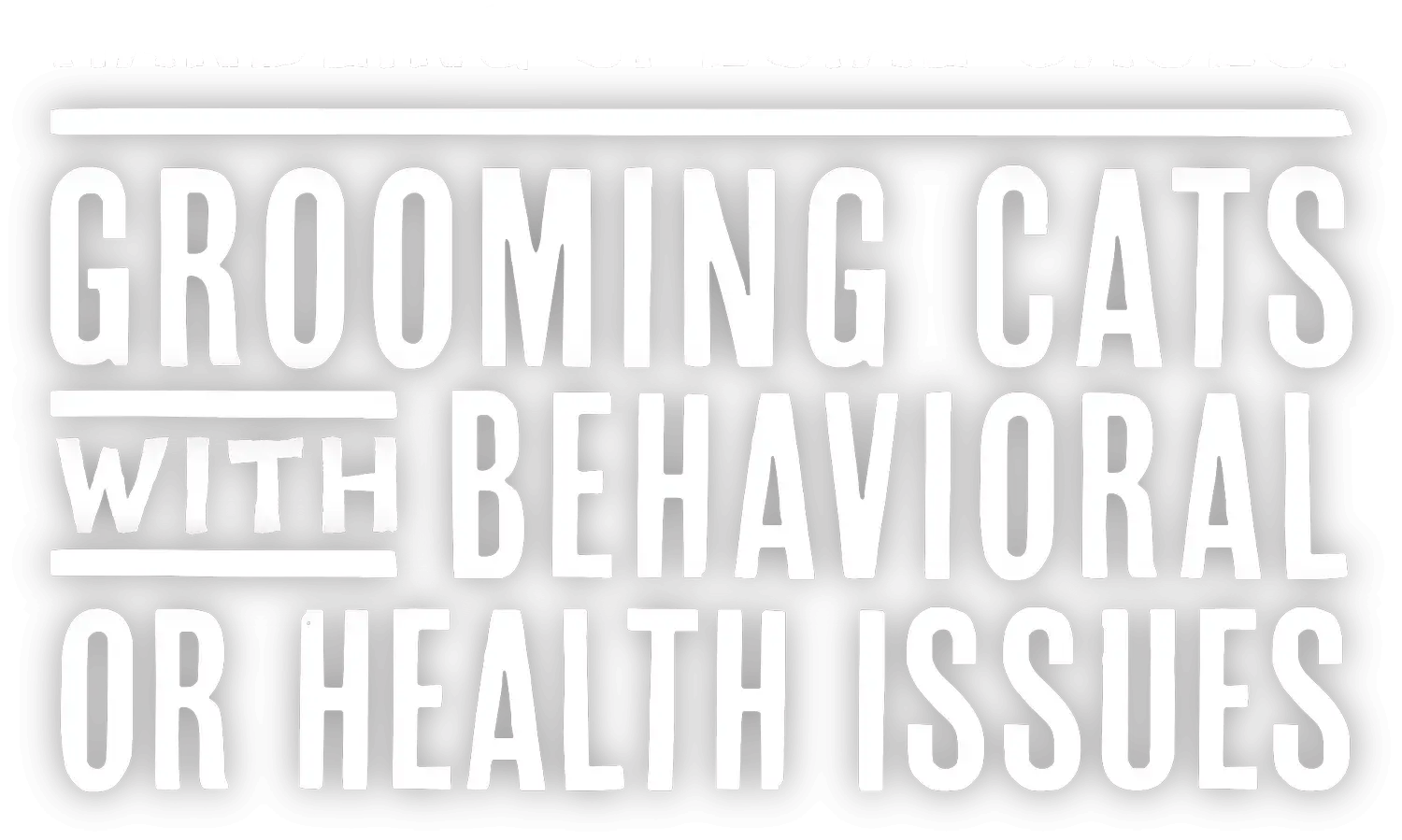
by Lynn Paolillo
by Lynn Paolillo
 rooming a cat requires patience, skill and a deep understanding of feline behavior. However, when working with cats with behavioral or health issues, the groom becomes even more complex. These special cases present unique challenges, demanding not only a groomer’s technical prowess, but also an exceptional level of empathy and adaptability.
rooming a cat requires patience, skill and a deep understanding of feline behavior. However, when working with cats with behavioral or health issues, the groom becomes even more complex. These special cases present unique challenges, demanding not only a groomer’s technical prowess, but also an exceptional level of empathy and adaptability.
Whether it’s a cat with a chronic health condition, an elderly feline, or one that’s easily stressed or aggressive, these grooms cannot be a cookie-cutter approach. This article aims to shed light on the intricacies of handling such special cases, offering guidance and insights to ensure the wellbeing of both the cat and the groomer.
Defining a Special Case
Health issues can also significantly impact a cat’s grooming experience. Conditions like arthritis can make handling painful, especially when manipulating limbs or applying pressure. Skin disorders, such as allergies or infections, can lead to soreness and sensitivity, causing a cat to react sharply to combing or clipping. Sensory impairments like vision or hearing loss can make a cat more easily startled or disoriented, leading to unpredictable reactions during grooming.
Before the Groom
During the initial client conversation and the pre-groom assessment, it is very important to manage the expectations of the owners. Be clear that while every effort will be made to ensure a positive grooming experience, there may be limitations based on the cat’s behavior or health conditions. Ensure they understand that the cat’s wellbeing is the priority, which may mean not all grooming tasks can be completed in one session.
Also respect your own comfort level and expertise. Some cats may require assistance from a second person or their needs may be beyond what can be safely managed in your grooming setting. It’s perfectly acceptable to refer these cases to a veterinary clinic for grooming services. This not only ensures the safety of the cat, but also maintains the integrity and professional standards of your grooming business. Remember, referring a cat to a more suitable grooming environment is a sign of professional responsibility and care, not an indication that you are incapable or are giving up.
Selecting Your Approach
Choosing tools and grooming services that avoid pulling or injuring the skin can also prevent discomfort, which is especially important for cats with skin conditions, sensitivities or whose skin is more fragile. For cats with arthritis, a soft surface can be more comfortable, such as a mat in the bottom of the tub, grooming in your lap or using plush towels underneath them. Additionally, limiting shaving on these cats will greatly reduce both discomfort and the risk of nicking skin. Preventative grooming like bathing, blow-drying and gentle combing will help keep mat removal to a minimum.

Don’t forget to continuously monitor the cat’s comfort.
Aftercare and Owner Education
In cases of arthritis, mobility issues, or cats showing signs of pain during handling or the grooming process, they should be given a quiet area to rest and owners should monitor the cat for any signs of distress or adverse reactions. It may also be appropriate for the owner to talk to their vet about potential pain-relief medication or supplements for future grooming sessions and/or for daily use for their cat.
Finally, regularly scheduled grooming appointments will keep their cat’s skin and coat in good condition, especially if the owner is unable to do the necessary amount of grooming at home. Provide a hand-out or other materials that the owner can take home to reinforce the information you’ve given them. By empowering owners with this knowledge, they can play an active role in the maintenance of their cat’s grooming needs and overall health.
Grooming cats with behavioral or health issues is a task that demands not just skill, but also a deep understanding and empathy for the unique challenges these cats face. From the initial assessment and the gentle handling during grooming to the critical aftercare, every step requires a tailored approach that prioritizes the cat’s comfort and safety. Educating owners is an integral part of this process, ensuring that the care and understanding extend beyond the grooming session.
As groomers, our role goes beyond mere aesthetics; it’s about contributing to the overall wellbeing of these special felines. By approaching each grooming session with patience, knowledge and compassion, we can make a significant difference in the lives of these cats and their owners, ensuring a positive and stress-free grooming experience for all.

by Jennifer Bishop Jenkins
 e face a tug-of-war every day we do our jobs as pet groomers. There are daily pressures on us to do our jobs “efficiently”—which usually means someone, or something, pushes us to do it as quickly as possible. But the stark reality is that we are not like most other people in most other jobs. We work on live animals; living beings that inject much unpredictability into our workday.
e face a tug-of-war every day we do our jobs as pet groomers. There are daily pressures on us to do our jobs “efficiently”—which usually means someone, or something, pushes us to do it as quickly as possible. But the stark reality is that we are not like most other people in most other jobs. We work on live animals; living beings that inject much unpredictability into our workday.
What is sometimes worse is that we are working with water, electricity, elevated surfaces, and loud, powerful and sometimes sharp equipment and tools that can be challenging to use and clean, not to mention can be very dangerous. Still, we have chosen to do this for a living because, as groomers, we truly care about the animals we groom. Why else would we work so physically hard at a job that can too often be a difficult, even dangerous one?
Add to that the pressures that are on us to work more quickly, and we must ask ourselves, how do we balance what must always be the top priority of safety for the pets we groom and for ourselves?
The challenges and solutions we face fall into two categories, depending on how we work: either we are self-employed and/or we are the boss or manager ourselves, or we work for someone else.
IF YOU ARE THE BOSS
We must also make sure all of the other tasks associated with the groom are accomplished as well: cleaning and disinfecting, client communication, record-keeping, equipment maintenance, laundry, and whatever else must be done to keep the business going. Take time to write a detailed list of everything that needs to be done in the day to do your job properly. I know this will take time, but it is time well spent. Putting it in writing really helps. And if you don’t have a Policy & Procedure Manual for your business, this will help you write one, making safety the priority.
Additionally, make sure you have optimized the shop layout, visibility, obstructions, escape routes, smoke alarms, good electrical, plumbing, HVAC and other infrastructure, fire extinguishers, lighting, flooring, all grooming equipment, tables, tubs, etc. Everything must work well and safely for the grooming experience.
Once you have a comprehensive document that lays out the big picture, you can start planning out your day, your week, and your month in a way that ensures important things happen and less important things that you don’t have time for are set aside. Make sure that you include all financial considerations. Do you need to raise your prices and take fewer dogs to ensure your business runs safely?
IF YOU WORK ALONE
If we work for someone else, they may not even be aware of the pressures we face in the actual day-to-day of our jobs that can lead to compromised safety practices. It is up to us to communicate the issues effectively with the person supervising us. Be specific. Describe the challenges. Place the wellbeing of the dog as your top priority. Show also that safety is essential not only to you and the dogs, but also to the success of the business. Communicate what you need to be able to do your job safely. Again, if the business needs to raise its prices and take fewer dogs, then they must do so, because the alternative is unacceptable.
Once these issues are brought to light, one of two things will happen: the person in charge of the groomers will make changes to the schedule, the load, the facility, the equipment, the expectations, what kind of help and support staff you have, etc., or they will not make any changes to help you be able to do your job more safely. And if that is the case, you have a choice: to stay in that job and risk the unthinkable (i.e., hurting a beloved animal or getting injured yourself), or you can leave that job. In this post-pandemic era of a measurable boom in our industry, you will very likely be able to find another one, perhaps an even better one. Or, you can go into business for yourself so that you are the one responsible for making safety the priority.
PRESSURES TO WORK FASTER
Commission Pay
A still common practice of compensation in our industry, commission-based pay for groomers is an old one and dates back to the days I still personally remember early in my career; days of very little infrastructure at all in the grooming industry. Most groomers worked out of their homes or other people’s homes or businesses, and most worked for cash under the table and on a commission basis. It was “piece work” where each dog was seen as its own job.
While the industry has improved dramatically in so many ways in the more than four decades I have been involved, and while salaried and hourly-wage grooming is now becoming the new normal, commission still persists as a practice in our industry. It has its pros and cons, but one concern I have is that it can take away from the larger view about the totality of the work we have to do in order to be safe: getting to know the dog, cleaning and disinfecting, careful handling of the dog, taking time to talk to the client, record-keeping, self-care, equipment maintenance, etc.
Many times I have seen groomers rush through their work because they reported to me that they were working on commission, so other priorities got ignored. Extra care around safety is often the first thing sacrificed under that kind of pressure. It doesn’t always happen that way, and it is possible to create a workplace that completely embodies a focus on safety and wellbeing of the staff and the dogs while being on commission, but a piece-work focus can sometimes interfere with building a bigger picture for the safety of all concerned.
Following the trend of most of the working world and the current direction the grooming industry is growing, putting all groomers on an hourly or salaried wage can be transformative. I was reluctant at first to change this practice in my own business, but once I made the switch to hourly and salaried, I became a believer. I saw more willingness from staff members to help each other. I saw better cleaning practices. I saw more emphasis on creating a positive, even fun experience for the dogs. I saw more information-sharing and a true team form where we all had a sense of ownership over all the dogs in our shop’s care.
When the focus is taken off the “piece work,” then all the extra steps like cleaning and safe handling practices are just part of the job. Commission, whether you like the practice or not, puts an undeniable pressure on the groomer to work faster than safety concerns might dictate. If groomers choose to continue the commission practice, at least consider raising your fees and reducing your load so that you can still earn a good wage while building in the time that is required to be incredibly careful at every step of the groom.
Daily Quotas from Management
Good business management and employee supervision includes creating a sense of rapport between management and staff where there are shared values: everyone works hard, has a well-understood sense of expectations, and where safety and the wellbeing of all concerned is valued above all other things.
Demanding Clients
MANAGING THE WHOLE
We should take that “view from above” on a regular basis to really examine the big picture, especially in safe practices. Set yourself a schedule and stick to it. Bring in an outsider that can put a fresh set of eyes on your situation to give you advice. There are many older, willing-to-mentor groomers around that are happy to come in and help you take a new look into your grooming practices to see what can be done to make it work better—and safer.
 n the pet care industry, having safety measures in place is crucial for the success of the business and the wellbeing of the pets being cared for, and that includes the equipment and tools that are used on a regular basis. Through routine maintenance, effective cleaning and sanitation, quality assurance and proper storage, groomers can ensure the safety of the pets in their care while prolonging the lifespan of their equipment and tools. Here we will cover some best practices to implement.
n the pet care industry, having safety measures in place is crucial for the success of the business and the wellbeing of the pets being cared for, and that includes the equipment and tools that are used on a regular basis. Through routine maintenance, effective cleaning and sanitation, quality assurance and proper storage, groomers can ensure the safety of the pets in their care while prolonging the lifespan of their equipment and tools. Here we will cover some best practices to implement.
Regardless, groomers should regularly inspect their tools and upgrade when the time is right based on manufacturer recommendations. Before every use, check batteries, cords and plugs for any nicks or signs of damage. For clipping specifically, periodically inspect the blade drive, hinge and lock to ensure no parts are rusted, worn or damaged. Although clippers are sealed, moisture and hair can sometimes work their way into the device. To prevent clogging, regularly lubricate, inspect and clean clippers to prevent any problems before they begin. If grooming tools have disposable components like clipper blades or grooming pads, be sure to replace them regularly.

Before each session, groomers should pre-soak tools in a rust-preventive, pet-safe disinfectant and diluted water solution. From there they can use a small brush, like a toothbrush, to scrub down tools, paying special attention to crevices and hard-to-reach areas to dislodge any remaining debris and ensure thorough cleaning. After soaking and scrubbing, rinsing the tools thoroughly with clean water will help to remove any residue. Allow the tools to air-dry completely before storing them, as drying prevents the growth of mold and bacteria.
For quick disinfection between sessions, use pet-safe disinfectant wipes to clean tool surfaces. This is particularly useful for scissors and shears, which may not be suitable for submersion. Aside from soaking, autoclaving and heat sterilizers can also be effective for certain tools.
While high-quality tools may come with a steeper upfront cost, the benefits can outweigh the initial investment. Those made with superior materials and craftsmanship will lead to greater durability, therefore providing better precision and a smoother operation. Established brands also typically offer warranties and reliable customer support, which can prove invaluable in case of defects or issues with the tools down the line.
Ergonomically designed tools and equipment can help reduce strain and fatigue on the groomer’s body. For instance, restraints like grooming loops, harnesses or non-slip surfaces can be attached to tables to provide extra support during long sessions while still safely securing pets. Each aid is adjustable to fit the size of the pet and should be snug, but not tight.
For electrical grooming tools such as clippers and dryers, consider using cord organizers or Velcro straps to properly secure and organize the cords to prevent tangles. For sharp instruments like scissors, shears and clippers, blade guards and covers will protect the sharp edges of blades, preventing accidental cuts and preserving their sharpness. Lastly, store tools in a cool, dry place. Avoid areas with high humidity, as moisture can lead to rusting, especially for metal tools.
Ultimately, one of the most important parts of a groomer’s job is ensuring the health and wellbeing of the pets in their care. Whether you’re new to the industry or a veteran pro, it’s vital that businesses prioritize safety on a regular basis. Through routine maintenance, effective cleaning and sanitation, quality assurance and utilizing proper storage, groomers can effectively maximize the functionality of the equipment and tools they use—all while creating a positive and safe atmosphere for both themselves and their pet clientele.

by Kathy Hosler
 e all know that just one bad bite or serious accident can put an end to our grooming career. And while it’s not possible to prevent every unexpected event, you can take precautions to minimize your risk.
e all know that just one bad bite or serious accident can put an end to our grooming career. And while it’s not possible to prevent every unexpected event, you can take precautions to minimize your risk.
I asked some stylists for their stories about experiences they have had that changed the way they groom, the equipment they use and the pets they will or will not accept. Here is what they had to say….
“In the beginning of my career, I stepped on my clipper cord,” Olga Zabelinskaya says. “The clipper flew and the blade hit my leg, there was a lot of blood everywhere. Since that time I use cordless clippers only.”
Peggy Hurt knows firsthand about accidents in the workplace. She suffered the consequences when someone was careless in the salon: “I was getting a dog out of the tub and someone had left a big bag on the floor behind me,” says Peggy. “I did not see it and I fell to the floor with the dog in my arms. The dog was fine, but I was out of work for a week.”
Helen Schaefer shared her shocking experience, which is one that she won’t soon forget: “I was electrocuted when I worked for a big-box store,” shares Helen. “One of the hoses from the kennel fans had an exposed wire. It electrified the entire cage bank. And stupid me thought it was static when I first touched the cage bank, so then of course the second time I touched it, it really buzzed me. We are lucky no dogs were injured.”
As if groomers are not busy enough around the holidays, Anjie Coates had to spend a couple of hours at urgent care during the week of Christmas: “I bought a new clipper vac and was installing it when it accidentally got turned on and shot off the wall,” Anjie recounts. “As it crashed down, the exhaust outtake landed on my finger and cut it to the bone. My business partner grabbed paper towels and kept telling me to squeeze it.
“My assistant drove me to urgent care where I told them I’m allergic to all local anesthetics,” Angie continues. “So they had to stitch it without anything, which freaked the guy out. I kept saying to him, ‘It’s fine, just sew it like a quilt. I can take it, go, go, go, I have dogs to groom.’
“They told me that I should not work for a week,” Anjie adds. “But I went back to the salon and groomed seven dogs. Lesson learned: Do not catch flying equipment!”
Bites are one of the most common injuries that groomers face on a daily basis. In addition to the pain of the initial bite, you may also experience infection, nerve damage, scarring, psychological trauma or post-traumatic stress.
bites are one of the most common injuries that groomers face on a daily basis. In addition to the pain of the initial bite, you may also experience infection, nerve damage, scarring, psychological trauma OR post-traumatic stress.
“Urgent care was able to remove the tooth, clean the wound, and start me on antibiotics immediately,” Tammy continues. “Two days later, the infection was spreading and the antibiotics were changed. All ended up OK, but now I’m extra vigilant when I’m drying pets.”
Veteran groomer Mary Arnold was bitten on the upper lip by a Dachshund and needed plastic surgery for the scar it left. Here she shares advice for others to help them avoid bites: “I think a big one is learning to read dogs,” Mary advises. “It’s always wise to err on the side of safety, such as putting a muzzle or E-collar on a dog that is giving you serious side eye.
“You should only be doing difficult dogs when you have someone to assist you that knows how to assist you,” Mary continues. “Also, embrace the idea that you do NOT have to offer service to every dog/client. Some are much better served at a veterinarian’s office under drugs.”
Lori Bowman agrees and adds, “I learned it’s not worth it to do aggressive dogs. They can injure themselves or me, and that’s just not worth the price a groom pays me. Some dogs are just not workable.”
Amy Brick Fioriello says, “I’ve been grooming 18 years, and on Friday I got a bad bite. Now, I need to see a hand surgeon because they are worried about my tendons.
“What did I learn from this?” Amy adds. “Never let an owner help with a bad dog. If I can’t get it done with the help of my employees, then they can take their pet somewhere else.”
Dogs aren’t the only ones who are prone to sinking their teeth into groomers. Just listen to these groomers’ stories about some cats they have worked on…
“I turned the water on the lowest setting to see how she would react,” Ellie continues. “The water never even touched her and she flipped out. She slipped out of her harness and jumped out of the tub. I was able to grab her when she landed on the floor. But since her ‘fight or flight’ was on, she went for my leg and really dug in. I was able to pry her off my leg and get her into her carrier without further injury.
“You should only be doing difficult dogs when you have someone to assist you that knows how to assist you. Also embrace the idea that you do NOT have to offer service to every dog/client.”
-Mary Arnold
Carla Freestep also ran afoul of a feline who objected to being bathed: “Early in my career, I was working at a veterinary hospital, and I was tasked with bathing a silver shaded Persian cat,” says Carla. “The cat was angry and sunk her teeth into my hand. It hurt, but I only had an hour or so left on my shift, so I figured I’d finish out and then go to the doctor.
“By the end of my shift, my hand was swollen, red, and throbbing,” Carla continues. “I went to the doctor and got some antibiotics, then went home. The next morning, my hand was swollen stiff, incredibly painful, and there was a red line crawling up my arm. I went back to the doctor and got a butt load (literally) of antibiotic injections. That got the infection under control, but it took about three weeks for my hand to heal.
“I learned that you don’t mess around with cat bites,” Carla says emphatically. “Get to the doctor ASAP. Even a scratch can make you sick.”
While not immune to unprovoked attacks, stylists who have been grooming for decades are usually savvy enough to know how serious a cat bite can be…
“I was finishing grooming a large domestic medium hair,” says Daryl Connor. “He’d had his nails trimmed, ears cleaned, been well-combed-out, and a bath. He tolerated being dried well, and I was almost finished when I saw one little area that needed trimming before I returned him to his carrier.
“Well, he had other plans, and sunk his fangs deep into my index finger. I believe I felt his canine tooth scrape my knuckle bone,” Daryl continues. “I performed good first aid, but knew it was a pretty serious injury. I loathe going to the doctor, but this time I went right away.
“The doctor told me to start on antibiotics and not to work the next day. He suggested I apply heat and elevate my hand. So, I took my first day off in eleven years. I wrapped my finger in a moist cloth, then in a heating pad, and kept it over my head all day. The bite felt better the next day and I returned to work. I believe my following doctor’s orders in this instance prevented me from a serious infection. It also brought home to me how dangerous a cat bite can be,” Daryl concludes.
As all of these stylists will attest, unexpected injuries can and do happen. But learning how to handle problem pets, keep your work area clear of hazards and your equipment in good repair may help you avoid a “horror story” of your own.


 s a pet groomer you want to create beautiful grooms quickly and efficiently without sacrificing quality, style and safety. This tutorial on a drop-coat mix makes grooming a breeze with the comfort of knowing you didn’t miss a single step!
s a pet groomer you want to create beautiful grooms quickly and efficiently without sacrificing quality, style and safety. This tutorial on a drop-coat mix makes grooming a breeze with the comfort of knowing you didn’t miss a single step!
Before beginning any groom, the first crucial step is to examine the dog. You want to get a feel for how much work is going to go into the groom and decide how much time you need to pace yourself for. In this process, you can identify areas that are dirtier or need more attention, like armpits, sanitary, hocks, neck, chest or face.

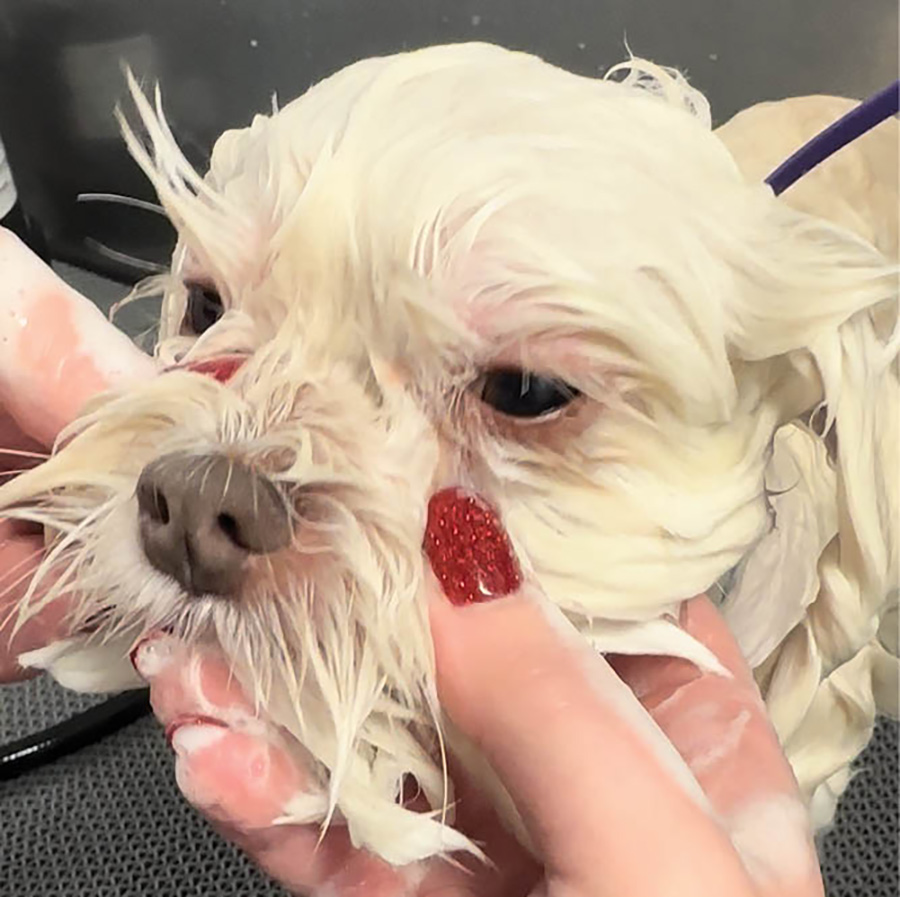


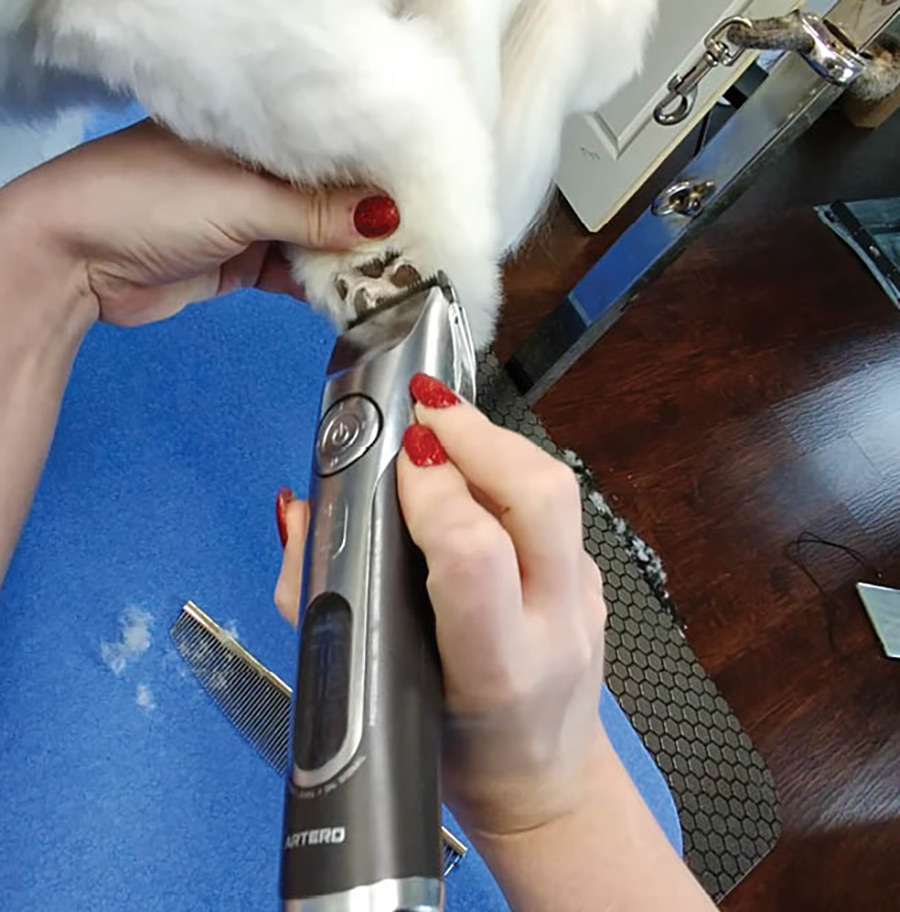
For the face, use the edge of your blade like a pencil tip to execute definition to the corners of the eyes. I like to use a #15 blade for the inner eye corner with my clippers pointing away from the eye, directing towards the nose. Then switch to a #10 blade placed in between the eyes at the stop, moving upward with light pressure to blend.
To complete your prep work, clean up the sanitary area.

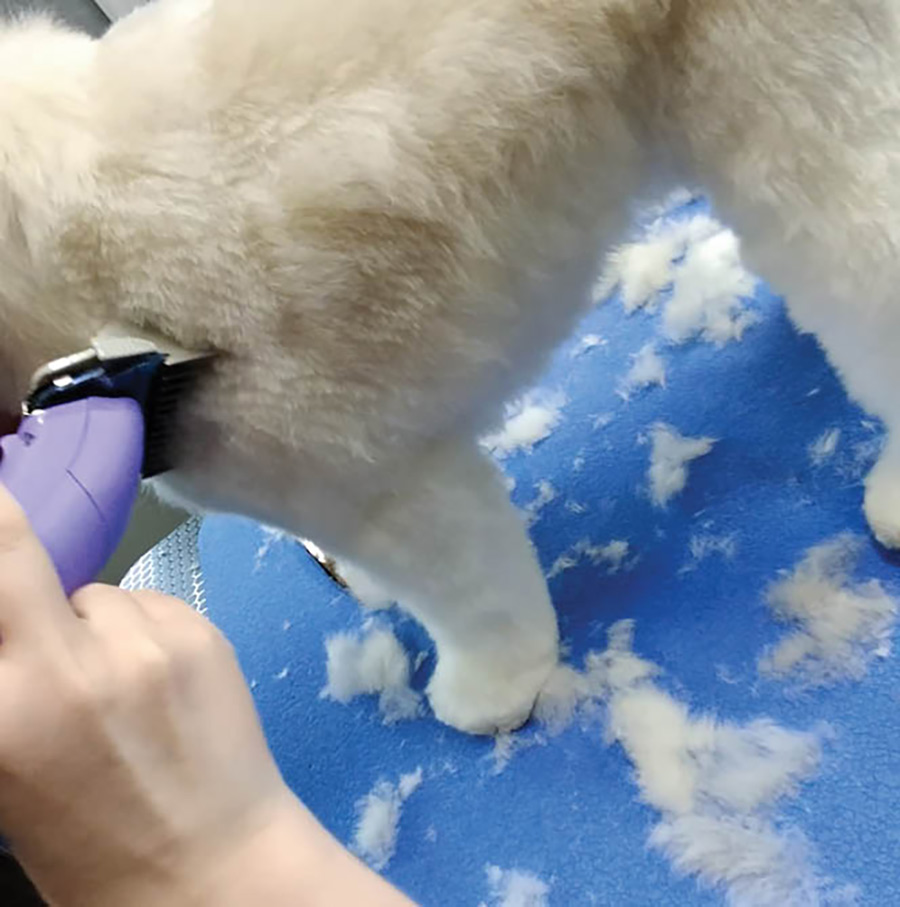



Then using the same blade, go over every leg. And just like the body work, I spritz, fluff and repeat.






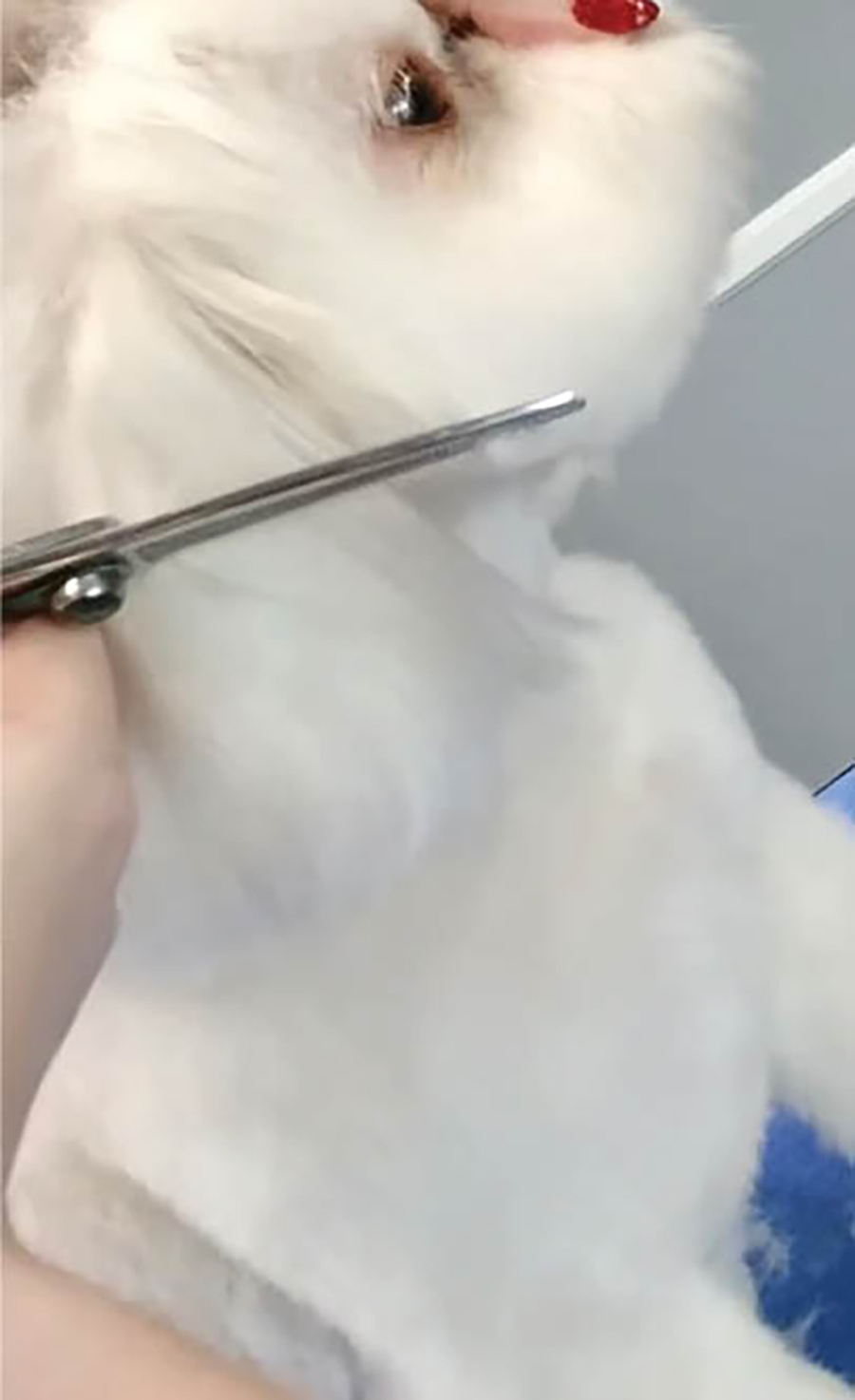

To finish, lightly trim the ears and tail, if the owner desires.
I find these steps are able to translate into every haircut I do. The variations never change, even in a shave-down or breed profile trim. You simply adjust the length and headpiece/tail/ears based on each pet. A trim like this can easily keep you efficient without wondering if you skipped a thing!
Photo by Anjie Coates
 oe is an adorable little Shih Tzu I have groomed her entire life. Ever since she was a puppy, Zoe has been just as sassy as she is sweet. Her Dad keeps her on a regular schedule and never misses her spa-day appointment.
oe is an adorable little Shih Tzu I have groomed her entire life. Ever since she was a puppy, Zoe has been just as sassy as she is sweet. Her Dad keeps her on a regular schedule and never misses her spa-day appointment. “Hi, Zoe! You ready for your bath?” I ask.
“Hi, Zoe! You ready for your bath?” I ask. Zoe: “Not particularly. I think I’ll nap for a while longer, thanks,” as she looks up at me with a yawn.
Zoe: “Not particularly. I think I’ll nap for a while longer, thanks,” as she looks up at me with a yawn. “Sorry, kiddo, you have to get into the tub. Angie is waiting for you by the little tub, she’s got your towels all warmed up and ready to go,” I tell her.
“Sorry, kiddo, you have to get into the tub. Angie is waiting for you by the little tub, she’s got your towels all warmed up and ready to go,” I tell her. Zoe: “Water nice and comfortable, too?”
Zoe: “Water nice and comfortable, too?” “Of course,” I reply.
“Of course,” I reply. Zoe: “Fine, carry me.”
Zoe: “Fine, carry me.” “You’ll feel reinvigorated after your bath, I promise, and you can nap when we’re done. I’ll wake you when your Dad comes,” I say.
“You’ll feel reinvigorated after your bath, I promise, and you can nap when we’re done. I’ll wake you when your Dad comes,” I say. Zoe: “Fine, but I want an extra treat.”
Zoe: “Fine, but I want an extra treat.” “That’s fair. I have a pretty dress for you to wear that’s just your size for the picture,” I tell her.
“That’s fair. I have a pretty dress for you to wear that’s just your size for the picture,” I tell her. Zoe: “I’ll decide if it’s pretty.”
Zoe: “I’ll decide if it’s pretty.” After her bath, I put Zoe on the table to finish her groom.
After her bath, I put Zoe on the table to finish her groom. Zoe: “Where’s my after-bath treat?”
Zoe: “Where’s my after-bath treat?” “Ahh yes, I almost forgot. Here you are, dear,” I say.
“Ahh yes, I almost forgot. Here you are, dear,” I say.
 Zoe: “Better. OK, let’s get this show on the road. I have a nap to take.”
Zoe: “Better. OK, let’s get this show on the road. I have a nap to take.” “But of course, my tiny bossy girl,” I reply.
“But of course, my tiny bossy girl,” I reply. Zoe looks at me unsure if that was a compliment but sees my grin and remembers I’ve told her that sassy dogs are always my favorites.
Zoe looks at me unsure if that was a compliment but sees my grin and remembers I’ve told her that sassy dogs are always my favorites. “OK, I know you hate getting your nails done, but we’ll do it quickly and I’ll make sure you have your gorgeous little round feet,” I say.
“OK, I know you hate getting your nails done, but we’ll do it quickly and I’ll make sure you have your gorgeous little round feet,” I say. Zoe: “I do have beautiful feet.”
Zoe: “I do have beautiful feet.” I laugh as I finish her nail trim and give her a tiny treat.
I laugh as I finish her nail trim and give her a tiny treat. Zoe: “Small enough?” And she gives me a side-eye.
Zoe: “Small enough?” And she gives me a side-eye. “Hey, you’re getting an extra in the picture room. I don’t want you to get an upset stomach,” I tell her.
“Hey, you’re getting an extra in the picture room. I don’t want you to get an upset stomach,” I tell her. I finish her haircut and we head to the picture room.
I finish her haircut and we head to the picture room. “Like this dress?” I ask as I hold up a heart-covered dress for her to inspect.
“Like this dress?” I ask as I hold up a heart-covered dress for her to inspect. Zoe: “I do!”
Zoe: “I do!” I slide the dress over her head and ask her to look at the camera.
I slide the dress over her head and ask her to look at the camera. Zoe poses for the camera and doesn’t move while I get the shot.
Zoe poses for the camera and doesn’t move while I get the shot. “You really are adorable,” I admit.
“You really are adorable,” I admit. I take her out from behind the kissing booth and she gives me a tiny kiss.
I take her out from behind the kissing booth and she gives me a tiny kiss. Zoe: “You love me.”
Zoe: “You love me.” “Yes, I do, my sassy little friend,” I reply.
“Yes, I do, my sassy little friend,” I reply. Zoe: “So, about those treats…”
Zoe: “So, about those treats…” And with a sigh I reply,
And with a sigh I reply,

(717) 691-3388 ext 224 to place a Classified.
$2.00 each
